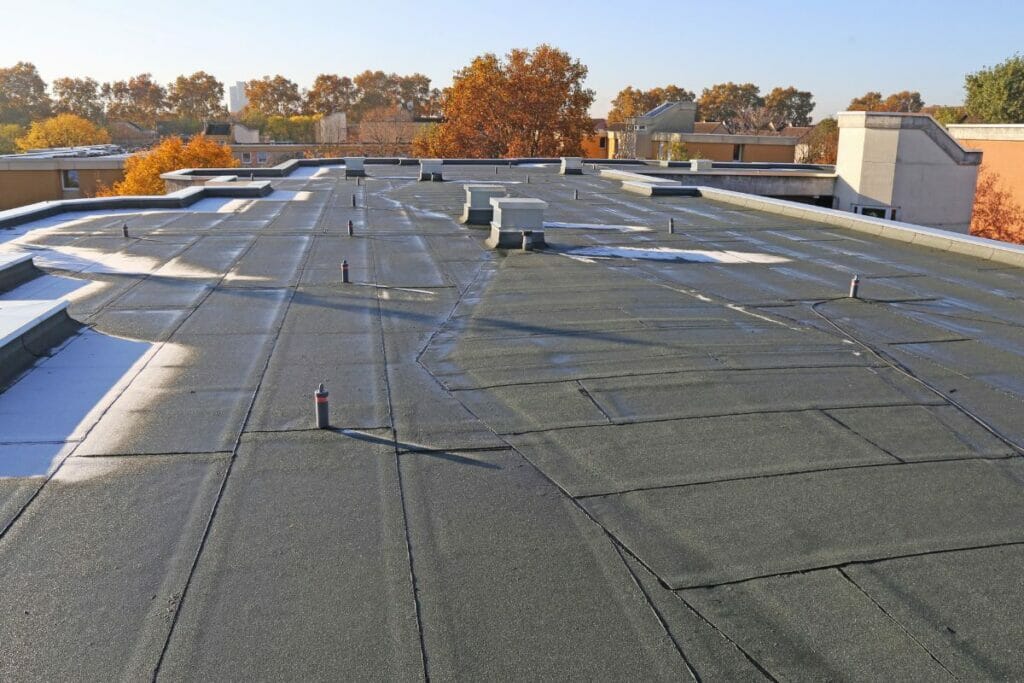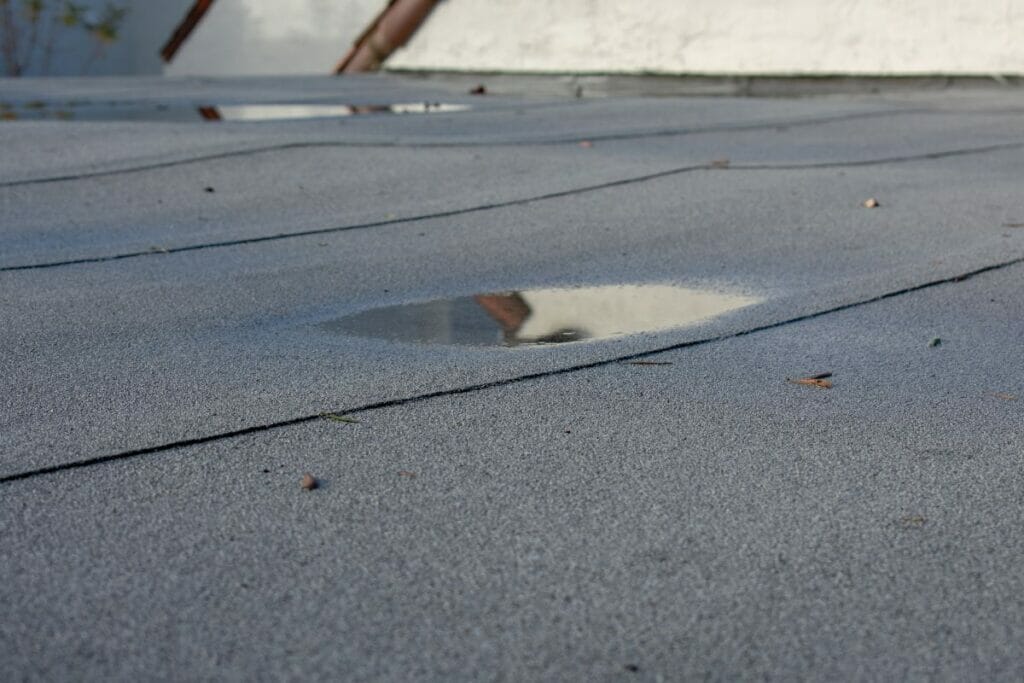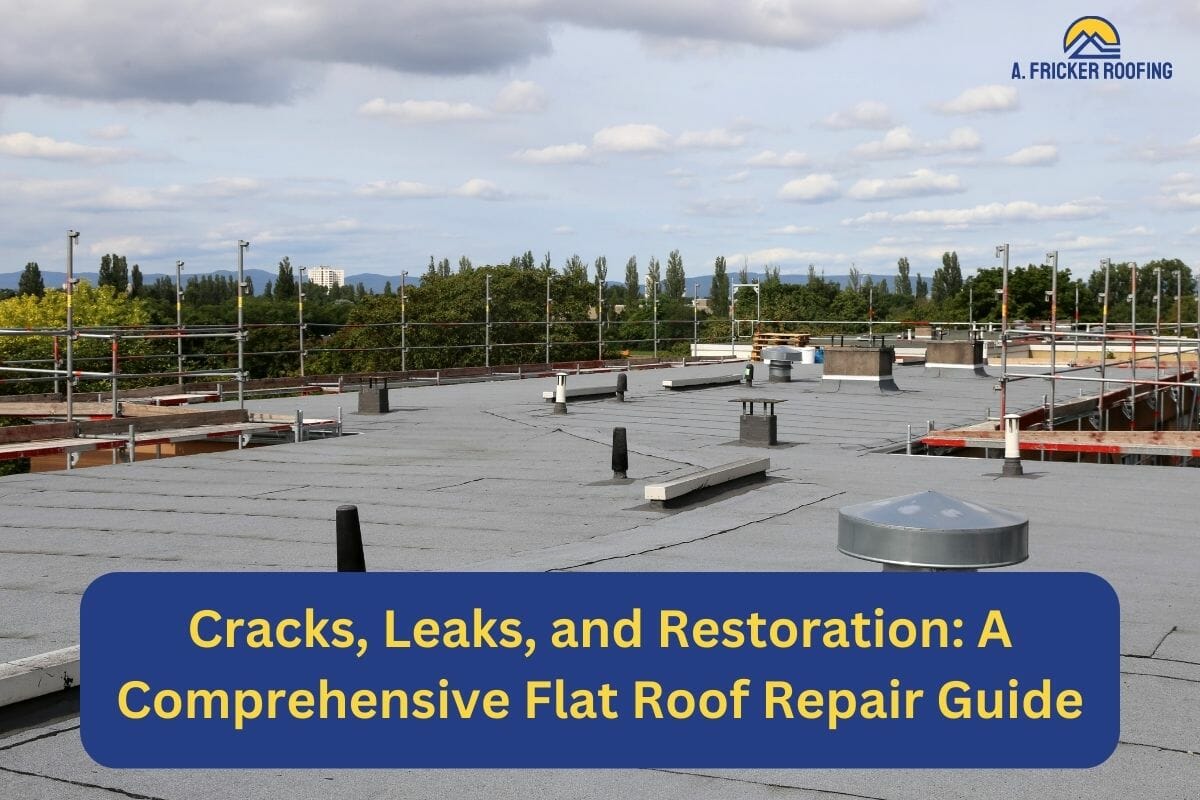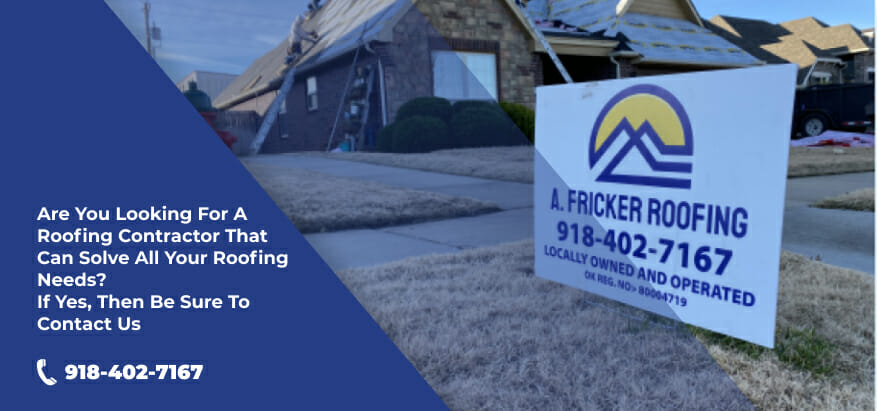Cracks and leaks in flat roofs are no less than a nightmare for building owners. Your roof is meant to protect you and the interior of your building from weather and other external elements. But when it gets damaged, there isn’t any time to spare.
As a locally-owned roofing contractor In Tulsa, it’s our job to help building owners in times of crisis like this. In this blog post, we will go over common issues your flat roof may face and how to address them before any severe damage is done.
Understanding Your Flat Roof

Your commercial flat roof is most likely made of either EPDM, TPO, or modified bitumen. These materials are usually installed on flat roofs for their durability, but this doesn’t make them leak or crack-free. Due to irregular maintenance, negligence of property owners, ponding water, and heavy weight on the surface, flat roofs are subject to cracking and leaks.
In addition, flat roofs, due to their low-sloped structure, can be subject to large amounts of standing water. This may be partially because of a poor drainage system.
Though flat roofs can last up to 50 years, they age faster because of early damages, such as cracks, blistering, alligatoring, and thermal contraction and expansion. If you start to notice leaks or other problems, it’s time to start repairing and restoring your roof.
What Causes Cracks And Leaks In Flat Roofs?
1. Weathering and Aging
One of the primary causes of cracks and leaks in flat roofs is weathering and aging. Exposure to harsh weather conditions, such as extreme temperatures, UV radiation, heavy rainfall, snow, and hail, can take a toll on the roofing materials over time. Continuous expansion and contraction due to temperature fluctuations can lead to cracks in the roof’s surface.
2. Ponding Water

Flat roofs have nowhere to shed water off the roof unless you have installed a proper drainage system. If ponding water accumulates and remains stagnant on the roof for extended periods, it can cause more severe issues to develop, including leaks and cracks.
Moreover, on flat roofs, finding the source of the leak can be difficult. Since the ponding water may cover large areas of the roof, the source may not be easily seen. Even the smallest holes in the roofing membrane can lead to major issues, so make sure to thoroughly inspect your roof when looking for the source of a leak.
3. Poor Installation and Workmanship
Improper installation is also another reason why cracks and leaks occur on flat roofs. Inadequate workmanship during the roof’s construction can result in various issues, including improper sealing of seams, weak joints, and faulty attachment of roofing materials. These flaws can compromise the roof’s integrity and lead to further problems.
4. Foot Traffic And Physical Damage
Flat roofs often have heavy equipment placed on them that can add excessive weight, causing roofing membranes to tear and age prematurely. Flat roofs on commercial buildings often serve as utility spaces or rooftop gardens, leading to foot traffic and potential physical damage. Increased weight from equipment, tools, or people can create areas more prone to cracks and leaks.
5. Environmental Debris
Leaves, branches, and other debris can accumulate on flat roofs, trapping moisture and promoting mold and algae growth. This can weaken the roofing materials and lead to further issues requiring repair. Regularly clearing the roof of debris and maintaining a clean surface can help prevent moisture buildup and preserve the roof’s integrity.
6. Material Quality
Ignoring the material quality before roof installation will most likely lead to major problems down the road. Before choosing a roofing material, it is important to consider various factors, including your local climate. Certain materials may be unsuitable for your area, leading to premature deterioration and failure of the flat roof.
How to Identify Cracks and Leaks in Flat Roofs

To maintain your flat roof’s integrity, it’s essential to be vigilant and look for signs of damage. Here’s a step-by-step guide to help you identify cracks and leaks:
1. Inspect Your Roof:
To prevent minor issues from turning into significant problems, conduct regular roof inspections. Inspect your flat roof at least twice a year, ideally in the spring and fall, to catch any damage early on.
2. Check For Water Stains:
Water stains on the ceiling or walls inside your building are telltale signs of roof leaks. Investigate these stains to locate the source of the leak on your flat roof.
3. Look For Bubbles Or Blisters:
Bubbles or blisters on the flat roof’s surface indicate trapped moisture. If these bubbles are left unaddressed, they can lead to cracks and eventually leaks.
4. Inspect Roof Flashing:
Roof flashing, the metal pieces around vents and edges, are common areas for leaks to occur. When conducting a roof inspection, inspect them for any damage or separation from the roof’s surface.
5. Check For Ponding Water:
Flat roofs are designed with a slight slope to allow water drainage. However, if you notice areas of standing water on your roof, it could indicate low spots or clogged drainage systems, leading to potential leaks.
6. Look For Mold Or Mildew:
Mold and mildew thrive in damp environments, making them common indicators of leaks. Check for any signs of these growths on the interior or exterior of your building.
7. Conduct A Water Test:
On flat roofs, as mentioned earlier, the source of leaks may not always be evident. Therefore, you need to go a step ahead to identify the leaking area. Perform a water test by using a hose to wet specific areas of the roof systematically. Have someone inside the building observe for any water penetration. This method can help pinpoint the leak’s location.
A Step-By-Step Process To Repair Cracks And Leaks On A Flat Roof
Tools Needed For Flat Roof Inspection
- Ladder
- Flashlight
- Chalk or marker
Materials Required For Flat Roof Repairs
- Roof patching compound
- Roof sealants for specific roofing materials (EPDM, TPO, modified bitumen)
- Reinforcing fabric or mesh
- Roofing nails
1. Repair Roof Leaks
Below is the systematic approach to fixing flat roof leaks.
A. Locating the Leak Source
The essential part of repairing leaks is tracing it to the source. It can be quite daunting, but with patience and by conducting a water test, you can easily find the right place where the water is leaking from. Trace the source of the leak by inspecting the roof during a rainy day or by simulating one with a hose.
B. Applying Roof Sealant
Sealants are a protective layer you can apply on your flat roof. Choose a suitable sealant for your roofing material and apply the sealants with a roller. If you have multiple leaks in your roof, consider applying it to all the parts. Don’t neglect the leak susceptible areas, like around skylights or flashing, as they can create a major problem later on. Due to ponding water, leaks are more likely to develop in these areas.
2. Ways To Repair Small Cracks
Small cracks can often be fixed with simple repair techniques.
A. Clean The Surface Area
Thoroughly clean the cracked area using a broom or brush to remove dust, debris, and loose particles. Removing dust is essential as it can interfere with the patching compound.
B. Apply Roof Patching Compound
Apply the roof patching compound generously over the crack, ensuring it covers the entire damaged section. Use a putty knife to spread the compound evenly.
3. Steps To Repair Large Cracks
For more extensive cracks, additional steps are required.
A. Reinforce The Crack
Place a reinforcing fabric or mesh over the crack to provide extra support for the patching compound.
B. Apply Roof Sealant
Apply roof sealant over the mesh and the crack, smoothing it out with a putty knife. The sealant will create a watertight barrier.
For the best results, hire a professional contractor to make the repairs for you!
Conclusion
Repairing leaks and cracks in flat roofs are a vital maintenance task that should not be overlooked. By understanding the common causes of damage and following the step-by-step repair methods outlined in this article, you can protect your flat roof and extend its lifespan. Remember to prioritize safety during inspections and repairs, and when in doubt, seek professional assistance to ensure your roof remains in optimal condition for years to come.
Hire Professional Roofers To Repair Your Flat Roofs
Flat roof repair requires a set of essential tools and skills that not everyone has. DIY flat roof repair may sound easy, but leaving any cracks and holes untreated can further damage your roof and may force you to pay more for extensive repairs. That’s where professional roofers come in. They can fully repair your flat roof and restore it to its pre-damaged condition.
If you have noticed cracks and leaks in your flat roof, consider hiring A. Fricker Roofing and Waterproofing in Tulsa, OK. We are a team of professional and expert roofers who you can trust for any of your roofing projects, whether it be a flat roof repair or a complete replacement. Call us today at (918) 402-7167!

